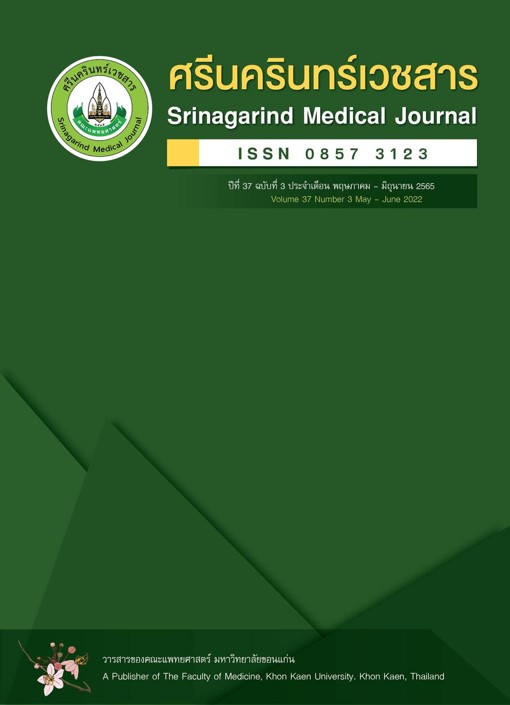Effectiveness of the Treatment of Hypertensive Patients in Community Pharmacy, in the Urban Primary Care, Muang District, Tak Province
Abstract
ประสิทธิผลของการรักษาผู้ป่วยโรคความดันโลหิตสูงที่รับยาร้านยาชุมชนอบอุ่นในระบบบริการปฐมภูมิเขตเมือง อำเภอเมือง จังหวัดตาก
รุ่งนภา ศิริพรไพบูลย์
กลุ่มงานเวชกรรมสังคม โรงพยาบาลสมเด็จพระเจ้าตากสินมหาราช
หลักการและวัตถุประสงค์: โครงการรับยาที่ร้านยาชุมชนอบอุ่นช่วยเพิ่มการเข้าถึงบริการสุขภาพและคุณภาพการรักษาพยาบาลของผู้ป่วยโรคความดันโลหิตสูงโดยการปรับเปลี่ยนพฤติกรรมและรับประทานยา การศึกษานี้มีวัตถุประสงค์เพื่อศึกษาประสิทธิผลของการรักษาผู้ป่วยโรคความดันโลหิตสูงที่รับยาร้านยาชุมชนอบอุ่น
วิธีการศึกษา: การศึกษา Historical controlled trials แบ่งผู้ป่วยโรคความดันโลหิตสูงเป็น 2 กลุ่ม ได้แก่ กลุ่มทดลองรับยาที่ร้านยาชุมชนอบอุ่น 319 ราย และกลุ่มควบคุมรับยาที่คลินิกหมอครอบครัวตากสิน 638 ราย วัดผลระดับความดันโลหิตที่ 3, 6 และ 12 เดือน ประเมินดัชนีมวลกาย ระดับน้ำตาลในเลือด ระดับไขมันในเลือด อัตราการกรองของไต และภาวะแทรกซ้อน เมื่อครบ 1 ปี วิเคราะห์ข้อมูลโดยใช้ Repeated Measures Analysis, Multivariable gaussian regression
ผลการศึกษา: กลุ่มรับยาร้านยาชุมชนอบอุ่นและกลุ่มรับยาคลินิกหมอครอบครัว มีระดับความดันโลหิต systolic และ diastolic ลดลงไม่แตกต่างกัน โดยระดับความดันโลหิต systolic ลดลงในอัตราเดือนละ1.13 และ 1.12 mmHg (p=0.775) ระดับความดันโลหิต diastolic ลดลงในอัตราเดือนละ 0.51 และ 0.47 mmHg (p=0.424) ส่วนผลลัพธ์ทางคลินิกอื่นๆ ไม่แตกต่างกัน
สรุป: การรับยาที่ร้านยาชุมชนอบอุ่น ผู้ป่วยได้ผลลัพธ์ทางคลินิกไม่แตกต่างจากคลินิกหมอครอบครัว
Background and Objective: The project is to receive medicines at the Community Pharmacy also to improve the access to health services and the quality of hypertension patients’ treatments through behavior modification and medication. The objective of the study was to investigate the treatment effect of hypertensive patients at the Community Pharmacy.
Method: Historical control trials were designed for hypertensive patients. The experimental group (n=319) received medicines at the Community Pharmacy. The control group (n=638) received medicines at Taksin Primary Care Cluster (PCC). After three, six and twelve months, blood pressure levels were compared between both groups. After one year, BMI, fasting blood sugar, lipid levels, GFR, and complications were compared. Data were analyzed by using repeated measures analysis, and multivariate Gaussian regression.
Results: There were not significantly different in systolic and diastolic blood pressure levels among the Community Pharmacy and PCC group. The systolic blood pressure declined 1.13 and 1.12 mmHg per month (p=0.775). The diastolic blood pressure declined 0.51 and 0.47 mmHg per month (p=0.424). Other clinical outcomes after 1-year follow-up were not significantly different either.
Conclusions: The clinical outcomes in the Community Pharmacy were not different from normal services at Primary Care Cluster.


